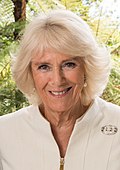This article needs additional citations for verification .(April 2021) |
| Duchess of Edinburgh | |
|---|---|
 | |
| First holder | Princess Augusta of Saxe-Gotha-Altenburg |
| Present holder | Sophie Rhys-Jones |
| Status | Extant |
Duchess of Edinburgh is the principal courtesy title held by the wife of the Duke of Edinburgh. There have been five Duchesses of Edinburgh since the title's creation. Following the accession of Charles III in 2022, the 3rd creation of the Dukedom of Edinburgh merged in the Crown. Following his parents’ wishes, on 10 March 2023, Charles III conferred the title Duke of Edinburgh on his youngest brother, Prince Edward, and his wife, Sophie, became the Duchess of Edinburgh.







